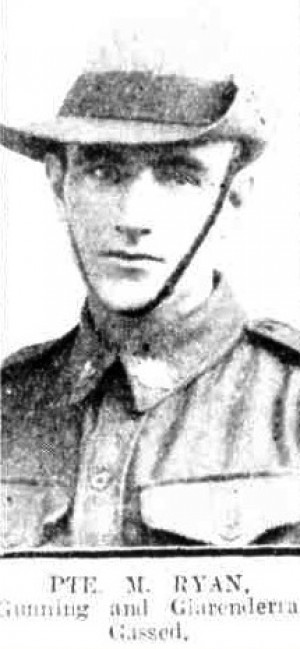Service Details
- Branch of Service
- Army
- Conflict
- World War I (1914-1918)
- Date of Enlistment
- 08/03/1916
- Date of Discharge
- 20/09/1919
- Place of Enlistment
- Sydney NSW
Personal Details
- Gender
- Male
- Other Name(s)
- Known as 'Mat' and first name sometimes spelt as 'Mathew'
- Place of Birth
- Michelago NSW
- Address (at enlistment)
- 270 Elizabeth Street, Sydney NSW (previously 'Horse Park', Gungahlin ACT)
- School(s) Attended
- Mulligans Flat School (Gungahlin)
- Occupation
- Labourer
- Next of Kin
- William Ryan (father), 'Boureong' via Gunning NSW
Unit and Rank Details
- Service Number
- 3618
- Final Rank
- Private
- Final Unit
- 30 Battalion AIF
Commemoration
Gunning District Soldier's Memorial
Notes
Matthew Ryan was born in the Michelago district in 1888, probably at ‘Mt. Allen’ on the Burra road, but the family moved to ‘Horse Park’ in 1895 after his father bought the property. However, when Ryan enlisted on 8 March 1916 he gave as his address a boarding house in Elizabeth Street in Sydney, the same address as his younger brother Ted who enlisted a few weeks before him. ‘Horse Park’ was in the process of being compulsorily acquired by the Commonwealth and this may have prompted their decision to enlist.
The brothers were farewelled by the people of Ginninderra in June 1916 and presented with a wrist watch and a cutlery set. Matthew Ryan embarked from Sydney in August 1916 with the 8th reinforcements for the 30th Battalion, arriving in France in December 1916. He was soon hospitalised with mumps but joined his battalion in the trenches near Flers on the Somme just after Christmas 1916. In March 1917 the Germans began a gradual withdrawal to the Hindenburg Line and it was the 30th Battalion which entered Bapaume shortly afterwards. Ryan fell ill with trench fever just as the Second Battle of Bullecourt began in May 1917 and did not rejoin his unit until August 1917. The following month the 30th Battalion fought at Polygon Wood in Belgium and in October 1917 they were positioned on Broodseinde Ridge near Passchendaele when Ryan was wounded by mustard gas and a gun shot to the buttock. He was sent to hospital in England to recover, trained afterwards as a signaller and returned to his unit in August 1918 in time for the major push by the Allies which resulted in the armistice with Germany being agreed to three months later.
Ryan returned to Australia and was discharged on 20 September 1919. His parents had bought the historic ‘Boureong’ property near Gunning after selling ‘Horse Park’ in 1916 and Ryan later inherited it. He never married and lived alone, suffering ill health in his later years. Matthew Ryan died from a self inflicted gun shot wound to the stomach at ‘Boureong’ on 19 November 1952. His younger brother Ted became a paraplegic due to shrapnel wounds and died in 1926. An 'M. Ryan' is referred to on the Ainslie Cricket Club roll of honour.
Description - height 5 feet 10 inches, 153 pounds, chest 35-37½ inches, dark complexion, blue eyes, black hair, Catholic.
Sources
National Library of Australia : Country Women's Association of NSW (Canberra Branch) History, 1959 (manuscript call no. NLA MS 734)
Queanbeyan/ Canberra Advocate - 8 June 1916, 12 June 1916
Queanbeyan Age - 9 October 1916, 4 December 1917
Sydney Mail - 17 July 1918
Goulburn Evening Penny Post - 20 November 1952, 27 February 1953
The Sydney Morning Herald - 22 November 1952
Lyall Gillespie, 'Ginninderra - Forerunner to Canberra', 1992
Canberra & District Historical Society Newsletter Aug. 1976 (p.11)
NAA RecordSearch - Series B2455 (First Australian Imperial Force Personnel Dossiers, 1914-1920)
